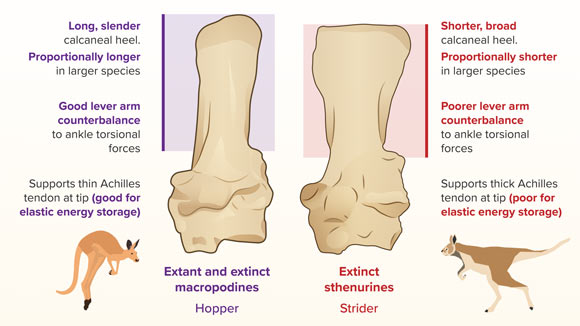In a new study, paleontologists from the United Kingdom and Sweden reviewed the fossil evidence of locomotion of kangaroos and their relatives (wallabies, tree-kangaroos, rat-kangaroos, etc.) over the last 25 million years. Their results indicate that the higher-speed endurance-hopping typical of modern large-bodied kangaroos was probably rare or absent in all but a few large-bodied lineages, including the direct ancestors of modern large kangaroos like red and gray kangaroos.

An artist’s impression of the giant kangaroo Nombe nombe (right) and other prehistoric animals from Nombe Rockshelter, Papua New Guinea. Image credit: Peter Shouten.
Macropodidae — the crown clade encompassing kangaroos, wallaroos, wallabies, pademelons, tree-kangaroos, the quokka, the banded hare-wallaby, and extinct short-faced kangaroos — constitutes the quintessential ‘eco-model’ for adaptive specialization towards higher speed endurance-hopping.
Despite the pervasive popular image of the QANTAS ‘flying kangaroo,’ the locomotory evolution of kangaroos and their more distant crown clade relatives is surprisingly diverse with documented fossil and living species evidencing a range of bipedal, quadrupedal, saltatorial, pentapedal, ambulatory, cursorial and scansorial locomotor modes, as well as burrowing behaviors developed over the last 25 million years.
The earliest recognized Late Oligocene-Middle Miocene (25 to 15 million years ago) basal types of kangaroos most likely employed quadrupedal bounding, climbing and slower speed hopping as their primary modes of locomotion.
Yet, all these early forms were small-bodied, below 12 kg, with larger bodied kangaroos over 20 kg not appearing until the Late Miocene (around 10 million years ago), coinciding with increasing aridity and the spread of openly vegetated habitats.
Hopping is functionally problematic at larger body sizes. Consequently, some members of the later kangaroo radiation achieved a more specialized anatomy for efficient higher-speed hopping at body sizes over 35 kg.
Modern large kangaroos are spectacular hoppers but none today are over 100 kg (most individuals under 70 kg) and many extinct forms were well above this size and physically too big to hop.
“We want people to appreciate that large kangaroos were much more diverse as recently as 50,000 years ago, which may also mean that the habitat in Australia then was rather different from today,” said University of Bristol’s Professor Christine Janis, first author of the study.
“In fact, modern large hopping kangaroos are the exception in kangaroo evolution.”

Illustration showing difference in calcaneal heels between hopper and strider. Image credit: Nuria Melisa Morales-Garcia.
While hopping apparently originated early in kangaroo evolution, in small-bodied forms, with the emergence of larger-sized kangaroos in the Late Miocene there were several different options: to become more specialized for large-bodied endurance hopping, as in the ancestors of modern kangaroos, or to adopt other forms of locomotion at higher speeds, as in two main extinct lineages.
The protemnodons (so-called ‘giant wallabies’, closely related to modern large kangaroos) likely relied upon a more quadrupedal type of locomotion most of the time, and rarely hopped.
The sthenurine short-faced kangaroos, a lineage that split from all modern kangaroos around 15 million years ago, apparently adopted bipedal striding at all speeds.
The new data on the length of the tibia (shin bone) and calcaneum (ankle bone) reinforce these earlier hypotheses of locomotor differences from modern kangaroos in these two extinct groups.
“Especially supported by this new data is the notion of bipedal striding rather than hopping in the sthenurines, as their calcanea lack the anatomy (a long calcaneal heel) that would help resist rotational forces at the ankle experienced during hopping, and suggests a more-erect limb posture rather than the crouched posture essential for hopping,” said co-author Adrian O’Driscoll, a Ph.D. student at the University of York.
“The assumption that increasing continent-wide aridity after the end of the Miocene selectively favored hopping kangaroos is overly simplistic,” Professor Janis said.
“Hopping is only one of many gait modes employed by kangaroos both in the past and today, and the fast endurance hopping of modern kangaroos should not be regarded as some ‘evolutionary pinnacle’.”
“What makes modern endurance-hopping kangaroos appear so unusual is the geologically recent extinction of similar animals who moved in different ways.”
“We are perhaps then in need of a rival Australian airline that covers shorter distances than QANTAS and boasts a novel motif of a striding sthenurine!”
The team’s paper was published in the Alcheringa: an Australasian Journal of Palaeontology.
_____
Christine M. Janis et al. Myth of the QANTAS leap: perspectives on the evolution of kangaroo locomotion. Alcheringa: an Australasian Journal of Palaeontology, published online May 25, 2023; doi: 10.1080/03115518.2023.2195895







